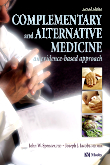|
|
|
| |
 |
|
|

|
 推薦指數:
推薦指數:





|
|
- 內容介紹
|
Complementary and Alternative Medicine, 2nd Edition - An Evidence-Based Approach
By John W. Spencer, PhD and Joseph J. Jacobs, MD, MBA
648 pages 26 ills
Trim size 6 X 9 in
Copyright 2003
Description
This popular, evidence-based overview of complementary and alternative medicine (CAM) emphasizes clinical research, analyzes the effectiveness of each therapy, and presents practical information on how these therapies can be used to treat health conditions and diseases. It not only acquaints the reader with information about CAM, but provides evidence for the effectiveness of various therapies used to treat medical conditions ranging from allergies to psychiatric conditions – in all populations relevant to CAM including children, women and the elderly. Summary tables embedded throughout highlight clinical data, statistics, and major research findings. More thorough documentation in this edition is achieved through new tables and added commentary on the quality of studies, making research findings more relevant and useful.
Key Features
Chapters are grouped according to condition and special populations rather than treatment, so readers can easily compare all possible treatments for a specific condition.
Up-to-date tables allow the reader to see what studies have been done for a certain condition, and what the findings are.
Extensive references and suggested reading lists refer the reader to the most up-to-date or historically relevant sources.
An emphasis on research and clinical studies gives the book a comprehensive focus on CAM treatments and results.
The evidenced-based approach clearly details which therapies are most effective and safe.
Up-to-date tables focusing on critical needs related to demographics, safety, and areas of clinical pain allow summary information to be quickly referenced.
Comprehensive, reliable content presents an unbiased account of CAM that allows the reader to follow the data without excessive commentary from the authors.
A focus on major medical conditions for which there is the most detailed and up-to-date information available allows the reader to learn about the major critical issues of CAM.
The ways in which research methodology can be used to practice evidence-based medicine is reviewed in several chapters.
A focus on special populations, including women, children, and the elderly, presents important CAM considerations for these groups.
New to this Edition
A new chapter on Legal and Ethical Issues addresses important professional considerations for practice related to CAM, including physician liability, malpractice issues, patient responsibility, and accreditation and licensing of CAM providers.
A new chapter on Integration of Clinical Practice and Medical Training with Complimentary and Alternative and Evidence-Based Medicine evaluating use of the case history approach; information and evidence in clinical practice and a model for integration of CAM used at the University of Arizona School of Medicine.
Significant content updates are provided for timely issues such as the use of herbs for depression, the use of massage for anxiety, CAM in pediatric and nursing care situations, and multi-modal therapies for pain.
Each table throughout the book has been extensively updated with the latest facts and information.
A final summary chapter at the end of the book presents emerging CAM treatments and suggests goals for CAM studies.
Much more attention has been paid in this edition to evaluating the quality of research, which allows for concrete and valid conclusions that are supported by science.
Appendices have been updated with much more information on research databases, listings, and organizations.
Table of Contents
1. Essential Issues in Complementary and Alternative Medicine 2. Pre-Clinical Research as a Bridge to Clinical Research Outcomes in Complementary and Alternative Medicine 3. Complementary/Alternative Therapies Used in the Treatment of Asthma and Allergies 4. Complementary/Alternative Therapies Used in the Treatment of Cancer 5. Complementary/Alternative Therapies Used in the Treatment and Prevention of Cardiovascular Disease 6. Complementary/Alternative Therapies Used in the Treatment of Diabetes 7. Complementary/Alternative Therapies Used in the Treatment of Neurologic Diseases 8. Complementary/Alternative Therapies Used in the Treatment of Psychiatric Disorders 9. Complementary/Alternative Therapies Used in the Treatment of Alcohol and Chemical Dependency 10. Complementary/Alternative Therapies Used in the Treatment of Pain 11. Complementary/Alternative Therapies Used in Select Populations: Children 12. Complementary/Alternative Therapies Used in Select Populations: Women 13. Complementary/Alternative Therapies Used in Select Populations: Elderly 14. Legal and Ethical Issues in Complementary/Alternative Medicine 15. Integration of Clinical Practice and Medical Training with Complementary and Alternative and Evidence-Based Medicine 16. Future Trends and Important Focuses for CAM in the 21st Century 17. Final Summary Appendix A: Definitions of Complementary/Alternative Therapies Described in the Text Appendix B: Selected Resources for Complementary/Alternative Medicine Appendix C: Research Databases Appendix D: Informed Consent Process Checklist for Physicians Integrating Complementary and Alternative Medicine Glossary Index
|
|
|

